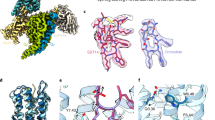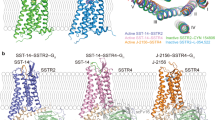Abstract.
Human somatostatin receptor subtypes 1–5 (sst1–5) were characterised using the agonist radioligands [125I]LTT-SRIF28, [125I][Tyr10]CST14, [125I]CGP 23996 and [125I][Tyr3]octreotide in stably transfected Chinese hamster lung fibroblast cells (CCL39 cells) . The radioligands used labelled saturable and high-affinity populations of sites in each instance; at sst1–4 receptors maximum binding (B max) was roughly equivalent. By contrast, at sst5 receptors B max determined with [125I]CGP 23996 and [125I][Tyr3]octreotide was significantly lower (two- and eightfold) compared with [125I]LTT-SRIF28 and [125I][Tyr10]CST14.
Experiments were performed with the stable GTP-analogue guanylylimidodiphosphate (GppNHp) to establish guanine nucleotide sensitivity of agonist binding to sst1–5 receptors. The sensitivity towards GppNHp was quite variable depending on receptor and/or ligand. At sst1 and sst4 receptors, GppNHp produced little effect overall, whereas binding to sst3 and sst2 receptors was reduced by 70 and >80%, respectively. At sst5 receptors, the binding of [125I]LTT-SRIF28 and [125I][Tyr10]CST14 was only slightly affected by GppNHp, while [125I]CGP 23996 and [125I][Tyr3]octreotide binding was almost entirely inhibited. Thus, [125I][Tyr3]octreotide labelled about 26-fold less sst5 receptors than [125I]LTT-SRIF28, in the presence of 10 µM GppNHp. These discrepancies in guanine nucleotide sensitivity, were confirmed in GppNHp competition experiments. Competition studies were performed at the five receptors labelled with the different radioligands to establish their respective pharmacological profiles: the rank order of affinity was largely radioligand-independent at sst1–4 receptors, in contrast to sst5 receptors where it was radioligand-dependent. Thus, the pharmacological profile of [125I]LTT-SRIF28- and [125I][Tyr10]CST14-labelled sst5 sites correlated highly significantly, but did not correlate with the affinity profiles defined with [125I]CGP 23996 and [125I][Tyr3]octreotide binding to sst5 receptors. Depending on the agonist radioligand used and the receptor studied, it would appear that binding can be essentially to a guanine nucleotide-sensitive state (e.g. sst2 or sst3), a guanine nucleotide-insensitive state (sst1 or sst4) or a mixture of both (sst5); in the latter case, each radioligand defining a more or less different rank order of affinity at the same receptor.
In summary, the differences in agonist receptor binding and guanine nucleotide sensitivity cannot be explained by the ternary complex model or its variations, but rather suggest the existence of multiple agonist-specific receptor states which vary from one receptor to another.
Similar content being viewed by others
Author information
Authors and Affiliations
Additional information
Electronic Publication
Rights and permissions
About this article
Cite this article
Siehler, S., Seuwen, K. & Hoyer, D. Characterisation of human recombinant somatostatin receptors. 1. Radioligand binding studies. Naunyn-Schmiedeberg's Arch Pharmacol 360, 488–499 (1999). https://doi.org/10.1007/s002109900141
Received:
Accepted:
Issue Date:
DOI: https://doi.org/10.1007/s002109900141




